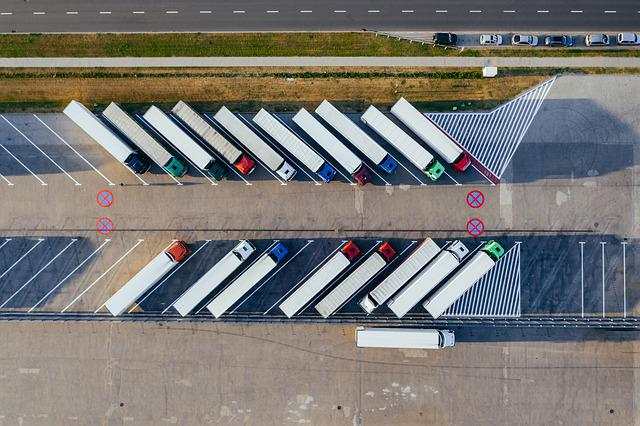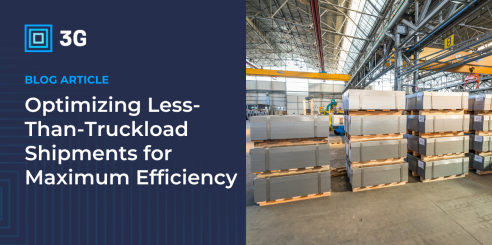Blog
3PL Logistics – 5 Tips to Guarantee 10x Returns in 2022

As companies race to become the next Amazon, more and more are turning to 3PL logistics providers to help them manage their supply chains. But with so many 3PLs, how do you know which one is right for your business? And once you’ve chosen a provider, how can you be sure that it will live up to its promise?
There’s a lot at stake when outsourcing your company’s logistics, but don’t worry – we’re here to help. Before we dive in, let’s first answer the simple questions.
What does 3PL mean in logistics?
3PL stands for third-party logistics. It’s a type of outsourcing that companies use to delegate their logistics and transportation functions to an external service provider. For many businesses, third-party logistics provide more cost-effective and efficient supply chain management than in-house.
With the rise of e-commerce, the demand for third-party logistics services will only grow. The global market for 3PL services is expected to reach $1.3 trillion by 2026. It’s no wonder that many companies are turning to 3PL providers to help them meet the demands of their logistics operations.
What are 3PL & 4PL Logistics?


3PL providers offer a variety of services across three main categories:
Transportation services & management — Getting your products from point A to point B, whether by land, sea, or air, including everything from route planning and optimization to tracking and visibility.
Warehouse and distribution — A third-party logistics provider can help you store your products in their warehouses, find warehouse space, and then provide fulfillment services to get your products to your customers quickly and efficiently. This can free up valuable space in your facility and save you time and money.
Value-added services — These are additional services that third-party logistics providers can offer to help you run your business more smoothly. Packaging, assembly, and even reverse logistics (returns management) are just a few.
4PL logistics, on the other hand, is a more comprehensive type of outsourcing that encompasses all aspects of the supply chain, from product development to customer service. 4PL providers are also often referred to as “supply chain integrators” as they offer numerous integrated services.
How Do You Save Money Using Third Party Logistics?


There are several ways cost savings can be achieved using third party logistics, including:
1) Reduced transportation costs
For businesses, reducing transportation costs is essential. One way to achieve this is to use 3PL, third-party logistics. Logistics management can positively impact an organization all along the chain.
Using third-party logistics companies to manage all or part of the company’s supply chains, including transportation, warehousing, and distribution can be an effective way to save on transportation costs, as the third party is typically able to negotiate better rates with vendors.
In addition, 3PL providers often have access to sophisticated logistics software that can help optimize the supply chain and cut costs. As a result, by using a third-party company, businesses can gain significant savings on transportation costs.
2) Increased efficiency
Another way that companies can save using 3PL services is by increasing their efficiency. When a company outsources its logistics functions to a 3PL provider, it can free up time and resources that are better used elsewhere.
In addition, businesses can optimize their supply chain and increase their efficiency by using a 3PL provider’s advanced logistics software. As a result, companies can save by using 3PL services to increase their efficiency.
3) Reduced inventory costs
Inventory is one of the most significant expenses for businesses. By using 3PL companies can reduce their inventory costs in a number of ways. First, by outsourcing their transportation functions to a 3PL provider, businesses can reduce the need for their warehouses and storage space.
This can save the company money on rent and other related costs. In addition, by using a 3PL provider’s inventory management software, businesses can more effectively track their inventory and avoid the costly mistakes that can occur when inventory is not managed properly.
4) Improved cash flow
Companies can improve their cash flow by using a 3PL. Outsourcing can free up cash in the company’s supply chain. This improved cash flow is used to invest in other business areas or fund other projects.
5) Increased flexibility
During periods of high demand, companies often find themselves short on staff and resources. This can lead to delays in the supply chain and poor customer service. By using 3PL companies can increase their flexibility and avoid these problems.
This is because 3PL providers can scale their services up or down as needed to meet the company’s changing needs. In addition, by using a 3PL provider’s advanced logistics software, businesses can more effectively manage their supply chain and make it more flexible.
6) Lower environmental impact
Many companies are now looking to reduce their environmental impact. One way to do this is to use a 3PL. This is because 3PL providers often have access to more fuel-efficient vehicles and can utilize alternative transportation methods, such as rail or air.
How Companies Benefit from 3PL


When done correctly, using 3PL providers can provide several benefits to businesses, including:
1) Improved customer service
In today’s fast-paced world, customers expect efficient and reliable service. Many companies are turning to third-party logistics providers (3PLs) to meet these expectations. 3PLs specialize in managing the entire supply chain, from transportation and warehousing to customs clearance and order fulfillment. By outsourcing these functions to a 3PL, companies can focus on their core competencies and provide their customers with the high levels of service they demand.
2) Access to new markets
Many companies find that the key to accessing new markets is partnering with a 3PL provider with a strong logistics network. By working with a 3PL, companies can tap into an existing infrastructure of transportation and warehousing resources, as well as expertise in areas such as supply chain management and customs clearance.
This can be a desirable option for companies looking to enter new markets but do not have the internal resources to build out their own logistics operations.
3) Reduced risk
When companies use third-party logistics (3PL), they outsource various transportation and warehousing functions to an experienced and specialized service provider. By doing so, they can focus on their core competencies while trusting that their logistical needs are being managed effectively and efficiently.
In addition to the operational benefits of outsourcing, using 3PL can also help companies reduce risk. 3PL providers have the expertise and resources to navigate the constantly changing landscape of transportation regulations, trade compliance, and environmental regulations.
They can also help companies avoid potential disruptions by proactively identifying and addressing potential problems. As a result, working with a 3PL can help companies reduce risk and operate more smoothly and effectively.
4) Increased capacity
Many companies struggle with how to increase capacity without breaking the bank. Adding more personnel, facilities, and vehicles can be costly and time-consuming. However, there is a way to increase capacity without incurring these costs- 3PL.
Third-party logistics providers specialize in managing transportation and warehousing for other companies. This means they have the personnel, facilities, and vehicles needed to handle an influx in business.
In addition, they can scale up or down as needed, giving companies the flexibility they need to respond to changes in demand. As a result, 3PL is an effective way for companies to increase capacity without incurring additional costs.
5) Improved flexibility
In today’s business world, being flexible and adapting to change is more critical than ever. Companies that can rapidly pivot to changing market conditions or customer needs have a significant competitive advantage. One way that companies can improve their flexibility is by using third-party logistics (3PL) providers.
3PL providers offer many benefits, including the ability to scale services up or down quickly in response to changes in demand, access to state-of-the-art technology and facilities, and the expertise of experienced professionals.
When choosing to outsource your company’s logistics to a third-party provider, keeping these benefits in mind is essential. Doing so will help you select the right 3PL for your business and ensure you realize the maximum return on your investment.
How to Outsource your Supply Chain


When it comes to your company’s supply chain, you have a few options. You can handle everything in-house or outsource some or all of the functions to a third-party logistics (3PL) provider. Each approach has pros and cons, and the one you choose will depend on your specific needs and objectives.
Outsourcing your supply chain can provide several benefits, including increased efficiency, flexibility, and reduced costs. In addition, working with a 3PL can help you focus on your core competencies while trusting that your logistical needs are being managed effectively and efficiently. When considering outsourcing your supply chain, there are a few things you should keep in mind, such as:
1. Defining your objectives — The first step is clearly defining your goals. What do you hope to accomplish by outsourcing your supply chain? Are you looking to reduce costs or improve efficiency? Once you know what you want to achieve, you can start evaluating 3PL providers who can help you meet those objectives.
2. Assessing your capabilities — It’s essential to closely examine your company’s capabilities before you start working with a 3PL. Do you have the internal resources to manage your supply chain effectively? Are there areas where you could benefit from some help? By understanding your capabilities, you can make sure that you’re outsourcing the right tasks to the right provider.
3. Evaluating providers — Once you know what you need, it’s time to start evaluating 3PL providers. There are several things you should look for, such as:
- Experience — Does the provider have experience working with companies in your industry? Do they understand your specific needs?
- Flexibility — Can the provider scale up or down to meet your changing needs? Are they able to adapt to your company’s growth?
- Cost — Is the provider’s pricing structure competitive? Are there any hidden costs that you should be aware of?
4. Negotiating the contract — Once you’ve found a provider you’re happy with, it’s time to negotiate the contract. This is an important step, as it will determine the terms of your relationship. Make sure you’re clear on what’s included in the contract and that you’re comfortable with the provider’s terms and conditions.
5. Managing the relationship — Once you’ve outsourced your supply chain, it’s essential to manage the relationship effectively. Be sure to set expectations with your 3PL provider and establish clear lines of communication. In addition, it’s crucial to track your supply chain’s progress and ensure that it’s meeting your objectives.
Outsourcing your supply chain can greatly improve efficiency and allow you to focus on your core competencies. By keeping a few things in mind, you can make sure that you choose the right 3PL provider and establish a successful relationship.
What to Look for When Choosing a 3PL Partner


When it comes to supply chain management, outsourcing to a third-party logistics (3PL) provider can be a great way to reduce costs and increase efficiency. But with so many 3PLs to choose from, it can be tough to know which one is right for your business. Here are five tips to help you choose the best third-party logistics partner for your company:
1. Make sure they have experience in your industry
You want to work with a third-party logistics provider that has experience serving businesses in your industry. They will be familiar with the unique challenges and opportunities that come with your particular type of business and will be better equipped to provide solutions that meet your specific needs.
2. Choose a 3PL that offers a comprehensive suite of services
The best third-party logistics providers provide a full range of logistics services, from transportation and warehousing to order fulfillment and customer service. This way, you can outsource as much or as little of your supply chain as you want, and you won’t have to worry about coordinating multiple providers.
3. Consider their geographical reach
If you have customers or suppliers located worldwide, you’ll need a third party logistics provider with a global network of warehouses and transportation partners. This will ensure that your goods can be shipped quickly and efficiently wherever they need to go.
4. Make sure they use advanced technology
The best 3PL providers use cutting-edge technology to streamline their operations and provide their clients with real-time visibility into every aspect of the supply chain. This way, you can always track your shipments and know exactly where your goods are at any given time.
5. Ask about their customer service
When entrusting your supply chain to a third party, you need to know that you can count on them to provide reverse logistics including excellent customer service. Ask about their communication protocols and how they handle customer inquiries and concerns.
6. Choose a 3PL that offers comprehensive security protocols
Security is always a top concern when outsourcing any part of your business, but it’s vital to your supply chain. Make sure the logistics and transportation services you choose has robust security measures to protect your goods from theft, damage, and other risks.
7. Make sure they offer competitive pricing
Of course, you’ll want to make ensure getting a good deal when you outsource your supply chain to a third party logistics service. Be sure to get quotes from multiple providers and compare their prices before deciding.
8. Ask about their sustainability practices
Sustainability is increasingly important to both logistics service providers and businesses, so you’ll want to make sure the 3PL is committed to reducing its environmental impact. Ask about their recycling and waste reduction practices and their carbon offsetting programs.
9. Make sure they have a good reputation
Before you choose a 3PL, do your research and read online reviews to get a sense of their importance. You’ll want to work with a provider with a history of happy customers and positive reviews.
10. Get a demo of their system
When considering different 3PL providers, be sure to ask for a demo of their system so you can see how it works and whether it’s a good fit for your business. This will help you make a more informed decision about which provider to choose.
By following these tips, you can be confident that you’ll choose a 3PL provider that is a good fit for your business and will help you achieve your supply chain goals.
Tips to Ensure Success when Working with a 3PL


There’s no doubt that 3PL providers can provide cost savings for a company. But how can you be sure you’re getting the most out of your 3PL partner? Here are five tips to help you make the most of your relationship and get the best possible return on investment.
1. Establish Clear Goals and Objectives
Working with a third-party logistics provider you should always begin with a clear understanding of your company’s goals and objectives. Ask yourself the following questions.
- What are you looking to achieve by outsourcing your logistics?
- Are you primarily concerned with cost savings or increasing efficiency?
- Do you need help managing seasonal spikes in demand?
- Are you looking for fulfillment services?
- Do you need third-party logistics warehouses?
Once you know what you want to accomplish, you can more easily select a 3PL with the expertise and capabilities to help you meet your goals.
2. Do Your Homework
Not all 3PLs are created equal. When evaluating potential partners, do your homework and ask around. Talk to other businesses in your industry to see who they use and why. Get references from your potential 3PL and follow up with them.
Once you’ve narrowed your options, take the time to tour each 3PL facility, warehouse space or fulfillment center, and meet their team. This will give you a good sense of their operation and whether or not they’re a good fit for your business.
3. Communicate, Communicate, Communicate
Outsourcing your logistics to a 3PL is a big decision, and you must stay involved throughout the process. Once you’ve selected a partner, communicate your expectations.
Set up regular meetings (weekly or monthly) to review progress and discuss any problems or concerns. The more you share with your 3PL, the better they’ll be able to meet your needs.
For better communication, try:
- Using a project management tool: It’s essential to clearly understand what tasks need to be completed and who is responsible for each one. Assigning tasks and deadlines through a project management tool will help ensure that everyone is on the same page.
- Holding regular team meetings: Besides meeting with your 3PL partner, keeping your internal team informed of progress and changes is also essential. This will help ensure a smooth transition and avoid any surprises down the road.
- Using a shared document or Google Drive: Having a central location where everyone can access the latest information (e.g., inventory levels, order status, etc.) can be invaluable. Ensure your 3PL partner has access to this shared document to stay up-to-date on your company’s needs.
4. Manage Inventory Carefully
If you’re not careful, managing inventory can be a real headache – especially if you’re working with multiple suppliers. To avoid potential problems, it’s important to have a clear understanding of your inventory levels.
Work with your 3PL to develop an inventory management system that meets your needs. This might include regular reporting, real-time alerts, or even automated reordering.
To manage your inventory, you can:
- Have a clear understanding of your inventory levels: If you know what you have in stock, it’ll be easier to avoid problems down the road.
- Work with your 3PL to develop an inventory management system: This will help you keep track of your inventory and ensure you’re always aware of what’s happening.
- Use regular reporting: This can help you spot trends and issues early on so you can take corrective action before it’s too late.
- Set up real-time alerts: This way, you’ll always know when your inventory levels are low and can act accordingly.
- Automate reordering: This can help ensure you never run out of inventory, even during spikes in demand.
5. Measure Performance Regularly
Once you’ve outsourced your logistics to a 3PL, it’s important to track their performance carefully. Establish key performance indicators (KPIs) upfront. Common KPIs for 3PLs include on-time delivery, order accuracy, and customer satisfaction.
By following these tips, you can be sure you’re getting the most out of your 3PL and maximizing your return on investment. With careful planning and regular communication, you can build a successful partnership that will help your business reach new heights.
How to Successfully Track Performance When Using a 3PL


There are a few key performance indicators (KPIs) that you should track when using a third-party logistics service, such as on-time delivery, order accuracy, and customer satisfaction. Doing so will help you identify areas where the 3PL is excelling and areas where there’s room for improvement.
To get started, establish KPIs and review them regularly. You can do this by yourself or with the help of your 3PL. Once you understand your KPIs well, start tracking them and taking note of any changes.
Here are a few tips to help you successfully track performance when using a 3PL:
1. Establish KPIs upfront
When tracking performance, it’s important to establish KPIs upfront. This will give you a good starting point for measuring the 3PL’s performance.
When establishing KPIs upfront, don’t forget to:
- Work with your 3PL: Be sure to involve your 3PL in setting KPIs. This way, they can provide input and help you choose indicators that are relevant to their operation.
- Keep it simple: Don’t try to track too many KPIs at once. Start with a few key indicators and add more as needed.
- Make it measurable: Make sure your KPIs are quantifiable to track them easily.
2. Review KPIs regularly
You should review your KPIs to get the most out of tracking performance. This will help you identify areas where the 3pl is excelling or where there’s room for improvement.
When you review your KPIs, be sure to compare them with previous periods. When reviewing your KPIs, don’t forget to compare them with prior periods. This will help you see if there’s been any progress or if there are any areas that need to be improved.
3. Track KPIs and take note of changes
Once you have KPIs established, track them and note any changes. This will help you identify any areas where the 3PL is falling short. During this process, communicate any areas of concern to the 3PL.
4. Communicate areas of improvement to the 3PL
If you see any areas where the 3PL is falling short, communicate this to them. By doing so, you can work together to find solutions and improve the overall performance of your logistics operation.
Communication is critical when it comes to tracking performance. If you see any areas of concern, reach out to the 3PL and have a discussion. During communication, don’t forget to:
- Be clear about your expectations: Make sure the 3PL know what you expect from them in terms of performance.
- Be specific about your concerns: When you communicate your concerns, be as detailed as possible. This will help the 3PL understand your position and find a solution.
5. Work together to find solutions and improve performance
The best way to improve performance is to work together with the 3PL. Communicating your concerns and finding solutions together will help improve the overall performance of your operation.
When working together to find solutions, don’t forget to:
- Focus on the future: Instead of dwelling on past mistakes, focus on finding solutions that will help improve performance in the future.
- Keep an open mind: Be willing to try new things and experiment with different solutions.
- Be patient: Rome wasn’t built in a day. Don’t expect miracles overnight. It takes time to find the right answers and see results.
6. Review your results and make changes as needed
After tracking performance for a while, review your results and make changes as needed. This will help you fine-tune your operation and ensure you’re getting the most out of your 3PL.
By following these tips, you can be sure to get the most out of your 3PL and improve the overall performance of your logistics operation.
The Bottom Line
Managing inventory, measuring performance, and communicating with your 3PL are all critical steps in ensuring a successful partnership. Outsourcing your logistics to a 3PL can be daunting, but it’s worth it if you do your homework and establish clear expectations upfront.
With careful planning and regular communication, you can build a successful partnership that will help your business reach new heights and will keep your logistics management in check.


